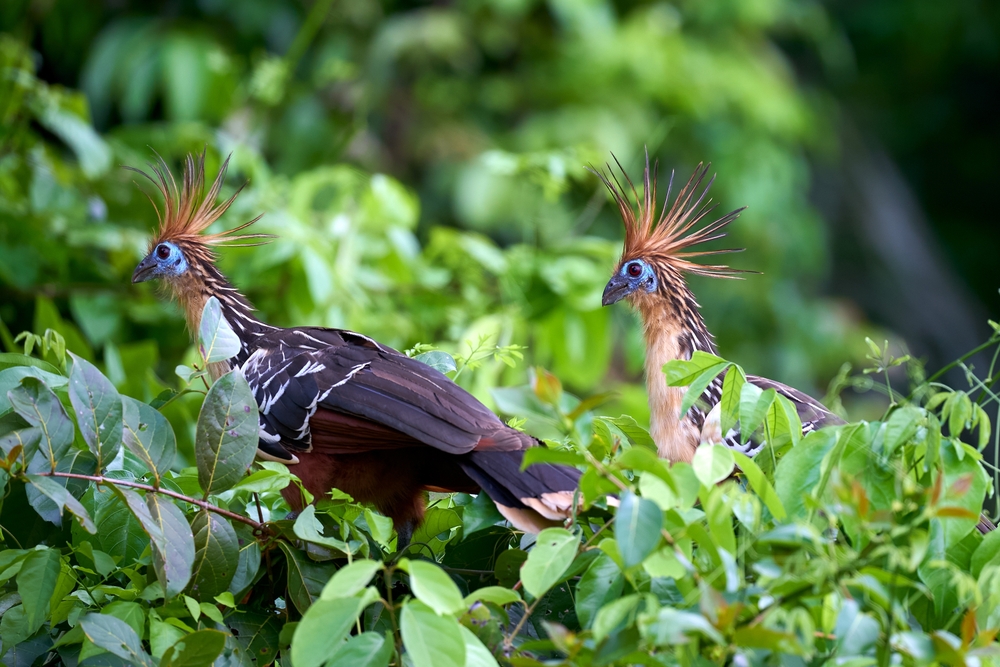The Hoatzin Is a Bizarre, Stinky Bird and Could Be An Ecotourism Star
Posted on Categories Discover Magazine

If you were to conjure up the strangest, hodge-podge creation of a bird in your mind, it would likely not be nearly as strange as the hoatzin (Opisthocomus hoazi), a species native to the Amazon rainforest that is also known as the stink bird or the flying cow.
That altogether unflattering name is apt, as this bird is renowned for the stench it leaves behind.
What exactly makes the hoatzin so stinky is its unique digestive system. As its diet is almost exclusively made up of leaves, the hoatzin has numerous small “stomachs” that allow its food to go through a fermentation process, much like cows. Like the notoriously belch-prone bovines, the hoatzin produces rather foul-smelling methane and particularly fragrant droppings.
This penchant for leaves — and the need to digest them — means that the hoatzin spends much of its day perched in place, doing nothing much at all aside from digesting.
What a Hoatzin Bird Looks Like
But this unique dietary habit is not the only remarkable trait this species has; looking at this rather plump bird, with its brightly colored mohawk-like crest and blue skin, is reminiscent of a chicken that’s taken a trip through the looking glass.
Hoatzin are also social creatures, and it’s common to see them perched together in flocks or family groups in trees or branches above the waterways and swampy areas they favor. They are widespread throughout Brazil and Colombia’s Amazon and Orinoco river basins. It’s also known as the national bird of Guyana and goes by the name of Canje pheasant.
Read More: Hummingbirds: The Smallest Birds in the World
Loud Noises from the Hoatzin Bird
In keeping with its unusual dietary habits and striking appearance, the hoatzin also possesses a vocal repertoire that is most peculiar and only adds to its uniqueness. Certainly, it is no songbird, as the species’ range of calls is variously described as a mixture of grunts, huffing, and chuffing. One can easily identify these birds in the forest canopy thanks to such loud noises.
Despite their wings, hoatzins are also not adept fliers. Adults take to the air only briefly when they move from tree to tree, and usually, they can be seen hopping and climbing between branches in a rather clumsy manner. Young hoatzin chicks are born with large claws on two of their wing “fingers,” which allows them to clamber and climb around on branches; this curious feature has drawn comparisons with the famous Archaeopteryx fossil.
As they are easily spotted, hoatzins are described as a “flagship” ecotourism species in the northern Amazon region. However, research suggests that flocks of tourists can spook these birds, inducing stress that can harm the survival of their young. These birds are also appealing to hunters, and it is believed that their numbers are declining due to habitat loss.
Read More: The Rare Courtship of Birds-of-Paradise
The Evolutionary Mystery of the Hoatzin
Evolutionarily speaking, the hoatzin is also a marvel unto itself and one that continues to puzzle scientists to this day. A study published in 2024 analyzed the genomes of over 360 bird species, creating a tree of life between major bird groups. But where exactly the hoatzin, the sole surviving species of its branch, sits is still uncertain, according to the researchers.
Since its discovery, researchers have lumped the bird under various groups, stating they have similarities to other birds, such as African turacos. It’s believed the hoatzin may have branched off from the rest of the bird tree of life around 65 million years ago; that’s a mere one million years after the cataclysmic extinction event that snuffed out the non-avian dinosaurs, for context.
Analysis of fossils suggests that what is today a uniquely South American bird may actually have had its origins in Africa or Europe. One theory goes that the hoatzin’s ancestors floated across the Atlantic on vegetation rafts. What is certain is that this stinky, clumsy, and slightly comical-looking bird is a feat of evolution. Despite its seemingly bizarre adaptations, it has managed to stand the test of its smelly time on Earth remarkably well.
Read More: 5 Things You May Not Have Known About The Dodo Bird
Article Sources
Our writers at Discovermagazine.com use peer-reviewed studies and high-quality sources for our articles, and our editors review for scientific accuracy and editorial standards. Review the sources used below for this article:
Sean Mowbray is a freelance writer based in Scotland. He covers the environment, archaeology, and general science topics. His work has also appeared in outlets such as Mongabay, New Scientist, Hakai Magazine, Ancient History Magazine, and others.